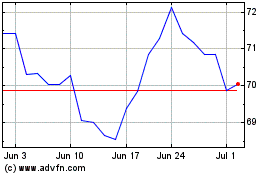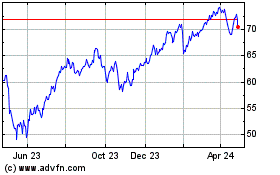MetLife to Shed Banking Unit - Analyst Blog
July 25 2011 - 10:52AM
Zacks
Last week, MetLife Inc. (MET) announced its
plan to sell MetLife Bank in order to avoid the stringent Federal
regulations, which it faces as a bank holding company.
MetLife is primarily an insurance company, whereby the banking
unit contributed to merely 2% of its operating earnings in the
first quarter of 2011. Although MetLife is the seventh largest bank
holding company in the U.S. on the basis of total assets, it lags
far behind the top 50 position on the basis of deposits.
This reflects the small scale of the company’s operation in this
area. Yet its classification as a bank holding unit impels it to
abide by all the strict rules and capital requirements imposed on
banks, including those imposed under the Dodd-Frank Act.
Therefore, management desires to liberate MetLife from these
regulatory strictures as they are adversely affecting the
non-banking businesses and putting it at a competitive
disadvantage. The company’s competitors such as American
International Group Inc. (AIG) and Prudential
Financial Inc. (PRU) are not bank holding companies and
hence, do not face the same statutory regulations.
However, MetLife will only sell its banking unit overseeing its
savings account, certificates of deposits and money market
accounts. Meanwhile, it will continue lending via residential
mortgages under its MetLife Home Loans business, which was launched
in 2008.
MetLife has appointed Deutsche Bank AG (DB) to
manage the sale. Besides, companies like Ally Financial and
CIT Group Inc. (CIT), which failed to buy ING
Direct, are now expected to bid for MetLife Bank.
While the sale will free MetLife from the regulations imposed on
bank holding companies, it might still be classified as a
systemically important financial institution (SIFI) by U.S.
regulators. The criteria for identifying SIFIs are expected to be
finalized by the end of this year. SIFIs will also be subject to
regulations, but they are not as strict as those for bank holding
companies.
We believe that the sale of MetLife Bank could minimize
regulatory hassles, it will also help the company focus on its core
insurance operations, thereby enhancing MetLife’s competitive edge
over the long term.
Currently, MetLife carries a Zacks #3 Rank, which translates
into a short term hold rating.
AMER INTL GRP (AIG): Free Stock Analysis Report
DEUTSCHE BK AG (DB): Free Stock Analysis Report
METLIFE INC (MET): Free Stock Analysis Report
PRUDENTIAL FINL (PRU): Free Stock Analysis Report
Zacks Investment Research
MetLife (NYSE:MET)
Historical Stock Chart
From May 2024 to Jun 2024

MetLife (NYSE:MET)
Historical Stock Chart
From Jun 2023 to Jun 2024
